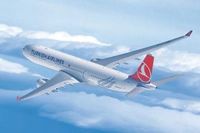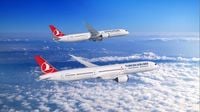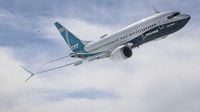Boeing and Turkish Airlines have made headlines yet again, this time with a record-breaking deal that is set to shape the future of global aviation. On September 26, 2025, Turkish Airlines confirmed an order for up to 75 Boeing 787 Dreamliners and expressed its intent to purchase as many as 150 Boeing 737 MAX aircraft, marking the largest-ever widebody order in the airline’s history and a bold move toward fleet modernization and expansion.
The agreement, as reported by AirlineGeeks, consists of 50 firm orders for the 787 Dreamliner family—35 of the mid-sized 787-9 variant and 15 of the larger 787-10—along with options for another 25 aircraft. The Dreamliners are scheduled for delivery between 2029 and 2034, and the deal’s financial details remain undisclosed. The announcement came just a day after Turkish President Recep Tayyip Erdogan met with U.S. President Donald Trump at the White House, where the prospect of aircraft sales was reportedly discussed. The timing, industry observers note, is no coincidence, reflecting the strategic importance of the deal for both nations’ economies and the aviation sector at large.
Turkish Airlines’ chairman, Ahmet Bolat, underscored the significance of the agreement in a statement released by the airline: “This landmark agreement represents much more than a fleet growth. It is a reflection of our leadership in the industry as well as our dedication to innovation and operational excellence. The addition of these advanced Boeing aircraft to our fleet will not only enhance our operational capabilities but also become a significant element supporting Turkish Airlines’ 2033 Vision of expanding our fleet to 800 aircraft.” Bolat further emphasized the broader impact, saying the deal would “support the development of Türkiye’s aviation ecosystem” and bolster the country’s tourism sector by offering greater connectivity and more long-haul destinations.
According to Economy Class and Beyond, the deal is part of Turkish Airlines’ ambitious “Vision 2033” project, which is tied to the company’s 100th anniversary. The airline aims to expand its fleet beyond 800 aircraft by 2033, with next-generation aircraft making up 90% of the fleet by that year and 100% by 2035. This expansion strategy is intended to support an average annual growth rate of 6%, increase operational efficiency, and reinforce Turkish Airlines’ position as a global leader in both passenger service and environmental responsibility.
Boeing’s Commercial Airplanes President and CEO, Stephanie Pope, expressed pride in the partnership, stating, “We are honored that Turkish Airlines has once again chosen the 787 Dreamliner and 737 MAX to power its future growth. As a proud partner to Türkiye and the Turkish aviation industry for 80 years, we look forward to continuing our support of Turkish Airlines as they expand operations and deliver exceptional experiences to their passengers.”
The new Dreamliners are expected to reduce operating costs through a 25% fuel efficiency advantage, while simultaneously increasing both passenger and cargo capacity. Turkish Airlines plans to deploy these aircraft on high-demand long-haul routes, particularly across the United States, Africa, Southeast Asia, and the Middle East. The airline currently operates 24 Boeing 787-9 aircraft, each with a seating capacity of 300 (30 in business class and 270 in economy), and the addition of the 787-10 will further boost its long-haul capabilities.
But the expansion doesn’t stop at widebodies. Turkish Airlines’ commitment to purchase up to 150 Boeing 737 MAX jets—subject to successful ongoing discussions with engine manufacturer CFM International—represents what will be its largest single-aisle order from Boeing when finalized. These narrowbody aircraft are crucial for enhancing efficiency and flexibility on short- and medium-haul routes, supporting the carrier’s extensive network that already includes nonstop service to 17 destinations in the U.S. and Canada, such as New York-JFK, Atlanta, Denver, Dallas/Fort Worth, Montreal, Los Angeles, and Toronto.
Currently, Turkish Airlines operates more than 200 Boeing aircraft, including the 787-9, 777, 737 MAX, Next-Generation 737, and 777 Freighter models. Its total passenger fleet hovers around 400 aircraft. Fleet data provided by Simple Flying and ch-aviation shows that, aside from the Dreamliners, Turkish Airlines’ Boeing fleet includes 69 737-800s, 15 737-900ERs, 27 737 MAX 8s, five 737 MAX 9s, and 36 777-300ERs. The order for additional 787s and 737 MAXs could effectively double the airline’s Boeing-made passenger fleet in the coming decade.
On the same day as Turkish Airlines’ blockbuster order, Norwegian Air Shuttle also made headlines by agreeing to purchase 30 Boeing 737 MAX 8s, increasing its 737 MAX order book to 80 aircraft. Norwegian CEO Geir Karlsen commented, “This milestone aircraft order is on attractive terms and secures our fleet growth in a way that supports our planned growth and sustainability targets. By exercising the options and adjusting the delivery profile, we maintain flexibility while reinforcing our commitment to operating one of the most modern and fuel-efficient fleets in Europe.” Norwegian was the first airline in Europe to take delivery of the 737 MAX in 2017, and this move signals its ongoing commitment to fleet renewal and environmental sustainability.
The impact of these major orders reverberated beyond the airlines and manufacturers. According to Investors Business Daily, Boeing’s stock price rose on September 26, 2025, following reports that the Federal Aviation Administration (FAA) would ease restrictions on aircraft deliveries, allowing Boeing to perform final safety checks for its 737 MAX jets. The positive regulatory news, coupled with the significant commercial wins from Turkish Airlines and Norwegian, gave Boeing a much-needed boost in market confidence after a challenging period marked by delivery delays and increased scrutiny.
Meanwhile, Turkish Airlines is still deep in negotiations with engine manufacturers Rolls-Royce and GE Aerospace for the Dreamliner fleet, reflecting the complexity and scale of such a transformative deal. The airline’s approach to procurement—balancing firm orders with options and ongoing negotiations—demonstrates a careful strategy to maintain flexibility while pursuing aggressive growth targets.
As Turkish Airlines forges ahead with its Vision 2033, the airline is not only betting on bigger numbers but also on newer, greener, and more efficient aircraft. The move is set to have ripple effects across the industry, supporting jobs, strengthening international ties, and, perhaps most importantly for travelers, expanding the horizons of where and how people can fly. With these orders, Turkish Airlines is positioning itself as a standard-bearer for global aviation—one that’s determined to set new benchmarks in efficiency, connectivity, and environmental stewardship.
With the ink barely dry on these historic agreements, all eyes will be on Turkish Airlines and Boeing as they navigate the next chapter in their long-standing partnership, shaping the skies for years to come.


